

The Man Who Told America the Truth About D-Day. Puffing on cigarettes and probably drinking a fair amount, Pyle spent the following days pecking away on his typewriter.

His readers needed his words to make sense of what “our boys” were enduring in France. After he had written enough material for a few columns, he wondered if his plain-spoken prose would be enough to help anyone back home understand what it was to be contaminated with so much death. Pyle’s first column about the D-Day landings, published on June 12, 1944, gave his readers an honest accounting of how daunting the invasion had been — and what a miracle it was that the Allies had taken the beaches at all. How Many Were Killed on D-Day? - HISTORY. It was the largest amphibious invasion in the history of warfare.
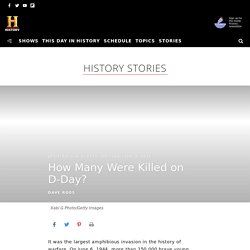
On June 6, 1944, more than 150,000 brave young soldiers from the United States, the United Kingdom and Canada stormed the beaches of Normandy, France in a bold strategy to push the Nazis out of Western Europe and turn the tide of the war for good. In planning the D-Day attack, Allied military leaders knew that casualties might be staggeringly high, but it was a cost they were willing to pay in order to establish an infantry stronghold in France. Days before the invasion, General Dwight D. Eisenhower was told by a top strategist that paratrooper casualties alone could be as high as 75 percent. Why African-American Soldiers Saw World War II as a Two-Front Battle. In July 1943, one month after a race riot shook Detroit, Vice President Henry Wallace spoke to a crowd of union workers and civic groups: “We cannot fight to crush Nazi brutality abroad and condone race riots at home.
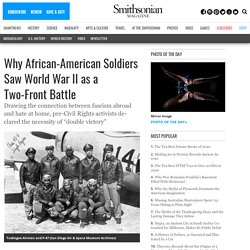
Those who fan the fires of racial clashes for the purpose of making political capital here at home are taking the first step toward Nazism.” The Pittsburgh Courier, a leading African-American newspaper at the time, praised Wallace for endorsing what they called the “Double V” campaign. The Double Victory campaign, launched by the Courier in 1942, became a rallying cry for black journalists, activists and citizens to secure both victory over fascism abroad during World War II and victory over racism at home.
There is a historical relationship between Nazism and white supremacy in the United States. But collective amnesia has consequences. Black Americans Who Served in WWII Faced Segregation Abroad and at Home. When the Selective Training and Service Act became the nation’s first peacetime draft law in September 1940, civil rights leaders pressured President Franklin D.
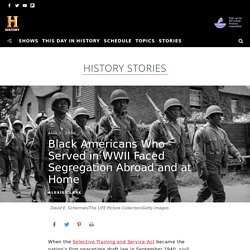
Roosevelt to allow Black men the opportunity to register and serve in integrated regiments. Although African Americans had participated in every conflict since the Revolutionary War, they had done so segregated, and FDR appointee Henry Stimson, the Secretary of War, was not interested in changing the status quo. African-American GIs of WWII: Fighting for democracy abroad and at home. (The Conversation is an independent and nonprofit source of news, analysis and commentary from academic experts.)
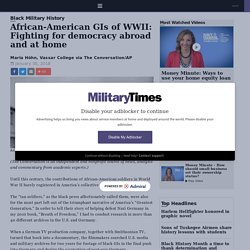
Until this century, the contributions of African-American soldiers in World War II barely registered in America’s collective memory of that war. The “tan soldiers,” as the black press affectionately called them, were also for the most part left out of the triumphant narrative of America’s “Greatest Generation.” In order to tell their story of helping defeat Nazi Germany in my 2010 book, “Breath of Freedom,” I had to conduct research in more than 40 different archives in the U.S. and Germany. World War II Records. For a comprehensive overview, see: Selected Finding Aids Related to NARA's World War II Holdings African Americans Records of Military Agencies Relating to African Americans from the Post-World War I Period to the Korean War , Reference Information Paper Casualty Lists and Missing D-Day D-Day Records at the National Archives Draft Records World War II Draft Registration: Use the National Archives Catalog for Ohio men born between April 28, 1877 and February 16, 1897, whose surnames began with "Aa" and "Ab" Electronic Records.
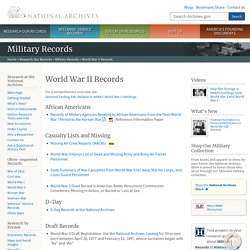
Research Starters: US Military by the Numbers. Take A Closer Look: America Goes to War. Higgins Industries designed and built two basic classes of military craft.
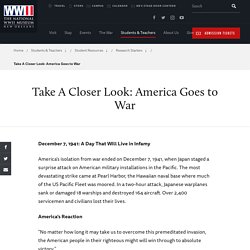
The first was landing craft, constructed of wood and steel and used to transport fully armed troops, light tanks, field artillery, and other mechanized equipment and supplies to shore. These boats helped make the amphibious landings of World War II possible. Higgins also designed and manufactured supply vessels and specialized patrol craft, including high-speed PT boats, antisubmarine boats, and dispatch boats. LCVP (Landing Craft, Vehicle, Personnel) The LCVP was the most famous landing craft designed and produced by Higgins Industries. It could land soldiers, and even jeeps, on a beach.
From the Eureka... ...to the LCP(L) During the 1930s Higgins tried to interest the U.S. The LCVP (Landing Craft, Vehicle, Personnel) was developed because the U.S. New Orleans" Home of the Higgins Boats "If Higgins had not designed and built those LCVPs, we never could have landed over an open beach.